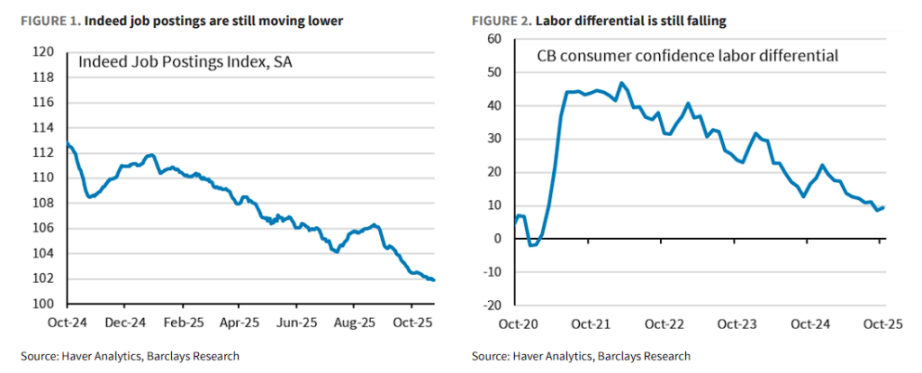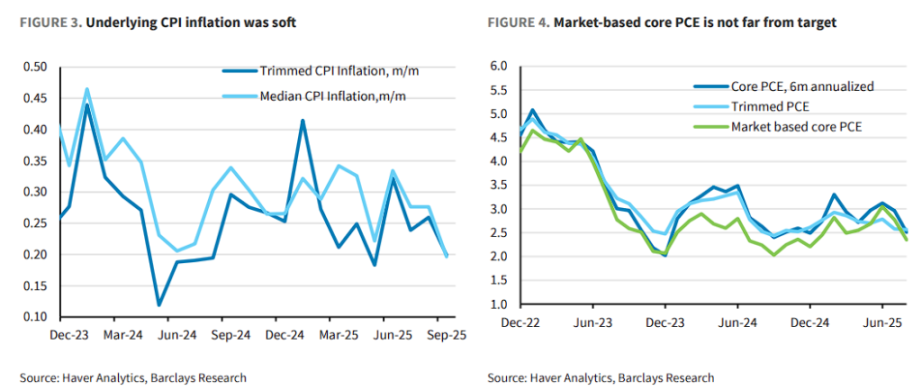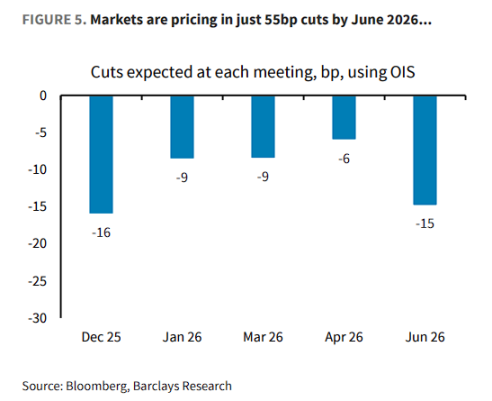Barclays believes that the market's hawkish interpretation of Powell's statements is a misjudgment.
Written by: Dong Jing, Wall Street Insights
The market's "hawkish" interpretation of Federal Reserve Chairman Powell's latest statements may be a misjudgment. Barclays believes that what Powell truly intends to do is correct the market's excessive confidence that "rate cuts are a done deal."
After the October FOMC meeting, the Federal Reserve Chairman stated at a press conference that inflation still faces upward pressure in the short term, employment is at risk of decline, and the current situation is quite challenging. There is still significant disagreement within the committee about whether to cut rates again in December, and a rate cut is not a certainty. The market interpreted these remarks as hawkish, leading to a sell-off in 2-year U.S. Treasuries, a sharp rise in yields, and a decline in U.S. stocks.
On October 31, according to news from the trading desk, Barclays Bank presented a clear opposing view in its latest research report, arguing that the market's panic may be a misjudgment. Powell's true intention is not to shift to a hawkish stance but to manage the market's overly "certain" expectations of rate cuts.
The analyst team led by Anshul Pradhan believes this is a communication strategy aimed at breaking the market's assumption that rate cuts are a certainty regardless of the data. The latest economic data shows that labor demand continues to slow, and the underlying inflation level is not far from the 2% target, all of which support the Fed's continued rate cuts.
Barclays pointed out in its report that the current market pricing is too hawkish and fails to adequately reflect the risk of a significant weakening in the labor market and the possibility that the new Federal Reserve Chairman may adopt a more dovish stance.
Not a hawkish shift, but breaking the market's "conclusion"
Barclays noted in the report: "We believe the main motivation is to refute the market's assumption that a rate cut in December is a done deal, rather than a hawkish shift in the Fed's response to the data."
In other words, the Federal Reserve wants to reaffirm that its decisions rely on data rather than being bound by market expectations. Powell clearly stated that the Fed will respond to the slowdown in labor demand, which is precisely what is happening.
The report emphasizes that the latest economic data not only does not support a hawkish stance but also provides a basis for further rate cuts.
Regarding the labor market, leading indicators, including job postings from Indeed and the labor gap (jobs plentiful vs. hard to get), indicate that demand is slowing.

On inflation, Powell also acknowledged the recent weak data. Core inflation indicators have shown a downward trend. Barclays' analysis suggests that once the impact of tariffs is excluded, the market-based core PCE inflation is close to the 2% target.

"Overall, if underlying inflation is only slightly above the target by a few tenths of a percentage point, and the unemployment rate is only slightly above the natural rate of unemployment (NAIRU) by a few tenths of a percentage point, then the policy setting should be neutral."
This means that, given the current data context, restrictive monetary policy is no longer necessary. Barclays observed that the market is currently pricing in a cumulative 55 basis points of rate cuts by June 2026, which is viewed as "too one-sided."

Currently, the market expects only a 35 basis point rate cut by March 2026 and a 55 basis point cut to 3.3% by June. The implied distribution in the options market shows that there is disagreement in the market regarding the number of rate cuts in March and June, with the modal expectation being only one rate cut by June.
免责声明:本文章仅代表作者个人观点,不代表本平台的立场和观点。本文章仅供信息分享,不构成对任何人的任何投资建议。用户与作者之间的任何争议,与本平台无关。如网页中刊载的文章或图片涉及侵权,请提供相关的权利证明和身份证明发送邮件到support@aicoin.com,本平台相关工作人员将会进行核查。




